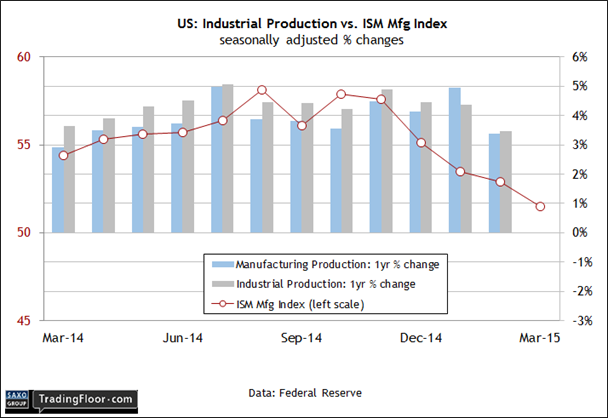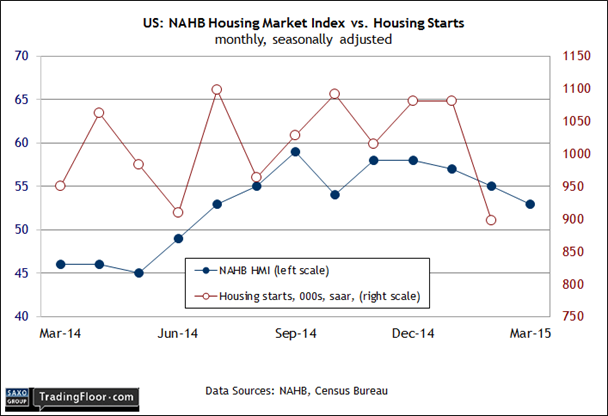The pace of economic releases picks up today, including the European Central Bank’s interest rate announcement and subsequent press conference. We’ll also see new data on US industrial production for last month and the April reading of mood in the US home building industry.
ECB Announcement (11:45 GMT) The economic news for the Eurozone continues to skew positive. Yesterday’s report on industrial production for February, for instance, delivered a sharply stronger-than-expected gain of 1.1% vs. the consensus forecast of just 0.3%. As result, output advanced 1.6 percent in annual terms, the most in nearly a year, according to Eurostat.
Meantime, the IMF’s newly published World Economic Outlook projects that economic growth for the Eurozone will accelerate this year, with GDP climbing 1.5% in 2015 – nearly double last year’s tepid 0.9% gain.
It’ll be interesting to see how the recent improvement in macro releases influences the tone of today’s 12:30 GMT press conference with ECB President Mario Draghi that follows the official update of the bank’s interest rate decision. Although it’s widely expected that the 0.05% policy rate will remain unchanged, the market will be keenly focused on what Draghi says and how he says it.
It's all about nuance vs. substantial changes at this point. With consumer price inflation far below the ECB’s target and signs of economic recovery still tentative albeit encouraging, the central bank chief will likely dismiss recent calls by hawks in some quarters for an early end to the quantitative easing program that was launched last month.
Meantime, there’s still plenty of macro uncertainty lurking, including the ever-topical issue of Greece. The embattled Eurozone country has been the subject of controversial reports this week about Greece’s reported plans for defaulting on its debt, which it quickly denied.
But the Greek sideshow aside, there’s a mildly stronger case for arguing that the Europe’s economy is on the mend. What does this mean for monetary policy for the rest of year? Draghi has the floor....
US: Industrial Production (13:15 GMT) Analysts are expecting another weak report for industrial activity. Econoday.com’s consensus forecast sees output sliding 0.3% in March vs. the previous month. If the forecast holds up, industrial production will continue to decelerate on a year-over-year basis, slipping to a modest 2.3% annual gain, which would mark the slowest increase since the summer of 2013.
If the expectations are accurate, the news will fuel new worries about the US economy. Although yesterday’s report on retail sales for March reflected a solid improvement in spending, the annual trend in consumption is still sliding. Most economists are still optimistic, however, arguing that retail spending will continue to recover in the months ahead. “Job gains, wealth gains, low gas prices and very high consumer sentiment would all point to solid consumer spending increases,” J.P. Morgan's chief US economist advised in a note to clients yesterday.
Maybe so, but if today’s data on industrial output is weak, it’s going to be tough to shake off the view that the US economy continues to struggle.
Meantime, business survey data for the manufacturing sector (the main driver of industrial activity) has been delivering mixed messages lately. The ISM Manufacturing Index fell to 51.5 for last month's reading, close to the neutral 50.0 mark. That’s a warning sign that today’s report for industrial output will be soft. On the other hand, the competing data via Markit Economics paints a brighter trend. The US Manufacturing PMI ticked up to a five-month high in March. “The U.S. manufacturing sector is clearly regaining momentum after a slow start to 2015,” said Markit’s chief economist this month.
The key question for today’s release: Does the Federal Reserve’s monthly report on industrial activity confirm Markit’s encouraging outlook or ISM’s forecast of an ongoing slowdown?

US: NAHB Housing Market Index (14:00 GMT) Today’s monthly update of sentiment among home builders will provide another clue for anticipating tomorrow’s data on residential construction. The worry here is that there are mounting signs of weakness in the housing sector.
Indeed, the number of housing starts decelerated sharply in February, dipping to an annualized seasonally adjusted rate of just 897,000 – the lowest in a bit more than a year and well below January’s 1,081,000 total. The optimistic view is that it’s just another case of a temporary winter setback. Perhaps, although the recent slide in the Housing Market Index (HMI) suggests that there could be more trouble ahead.
In last month’s report, the National Association of Home Builders’ HMI fell to 53, the closest to the neutral 50.0 mark since last summer. “Even with this slight slip, the HMI remains in positive territory and we expect the market to improve as we enter the spring buying season,” said NAHB’s chairman last month. “The drop in builder confidence is largely attributable to supply chain issues, such as lot and labour shortages as well as tight underwriting standards.”
Economists seem to agree. The consensus forecast via Econoday.com calls for a modest rebound in today’s HMI data for April: a rise of two points to 55. If so, expectations will get a lift for tomorrow’s hard-data update on housing construction.

Disclosure: Originally published at Saxo Bank TradingFloor.com
